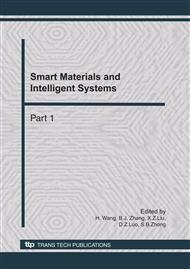[1]
G. Ting, H. Tong-sen, and T. Xian-zhong, Human face expression recognition based on within-class modular PCA. Mechanical & Electrical Engineering Magazine, (2009).
Google Scholar
[2]
S. Miao, and J. Zhang, Facial expression recognition based on 2 D-DWT and ICA. Jisuanji Gongcheng yu Yingyong(Computer Engineering and Applications), Vol. 44 (2008), pp.188-191.
Google Scholar
[3]
Y. Cheon, and D. Kim, Natural facial expression recognition using differential-AAM and manifold learning. Pattern Recognition, Vol. 42 (2009), pp.1340-1350.
DOI: 10.1016/j.patcog.2008.10.010
Google Scholar
[4]
L. Zilu Ying, J. Gan, and S. He, Facial Expression Recognition with Local Binary Pattern and Laplacian Eigenmaps. in Proceedings of the 5th International Conference on Intelligent Computing, (2009), p.228.
DOI: 10.1007/978-3-642-04070-2_26
Google Scholar
[5]
I. Buciu, and I. Pitas, NMF, LNMF, and DNMF modeling of neural receptive fields involved in human facial expression perception. Journal of Visual Communication and Image Representation, Vol. 17 (2006), pp.958-969.
DOI: 10.1016/j.jvcir.2006.06.001
Google Scholar
[6]
M. Turk, and A. Pentland, Eigenfaces for Recognition. Journal of Cognitive Neuroscience, Vol. 3 (1991), pp.71-86.
Google Scholar
[7]
D. Lee, and H. Seung, Learning the parts of objects by non-negative matrix factorization. Nature, Vol. 401 (1999), pp.788-791.
DOI: 10.1038/44565
Google Scholar
[8]
D. Donoho, and V. Stodden, When does non-negative matrix factorization give a correct decomposition into parts. Advances in Neural Information Processing Systems, Vol. 16 (2004), pp.1141-1148.
Google Scholar
[9]
T. Van de Cruys, A Non-negative Tensor Factorization Model for Selectional Preference Induction. GEMS: GEometrical Models of Natural Language Semantics, (2009), p.83.
DOI: 10.3115/1705415.1705426
Google Scholar
[10]
S. Zafeiriou, Algorithms for Nonnegative Tensor Factorization. Tensors in Image Processing and Computer Vision, (2009), p.105.
DOI: 10.1007/978-1-84882-299-3_5
Google Scholar
[11]
S. Zafeiriou, Discriminant Nonnegative Tensor Factorization Algorithms. IEEE Transactions on Neural Networks, Vol. 20 (2009), pp.217-235.
DOI: 10.1109/tnn.2008.2005293
Google Scholar
[12]
Z. Yang, and J. Laaksonen, Multiplicative updates for non-negative projections. Neurocomputing, Vol. 71 (2007), pp.363-373.
DOI: 10.1016/j.neucom.2006.11.023
Google Scholar
[13]
D. Lee, and H. Seung, Algorithms for non-negative matrix factorization. Advances in Neural Information Processing Systems, (2001), pp.556-562.
Google Scholar
[14]
S. Li, X. Hou, H. Zhang, and Q. Cheng, Learning spatially localized, parts-based representation. in Proceedings of IEEE Conference on Computer Vision and Pattern Recognition, (2001), pp.1-6.
DOI: 10.1109/cvpr.2001.990477
Google Scholar
[15]
T. Hazan, S. Polak, and A. Shashua, Sparse image coding using a 3D non-negative tensor factorization. in Proceedings of International Conference of Computer Vision, (2005), pp.50-57.
DOI: 10.1109/iccv.2005.228
Google Scholar


